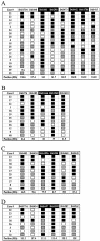Chromosome 6 suffers frequent and multiple aberrations in thymoma
- PMID: 12368223
- PMCID: PMC1867301
- DOI: 10.1016/S0002-9440(10)64426-4
Chromosome 6 suffers frequent and multiple aberrations in thymoma
Abstract
Thymoma is the most frequent tumor arising in human thymus. In this study, we performed a detailed mapping of deleted regions on chromosome 6 shown previously to harbor the most frequent genetic aberrations in this cancer. We analyzed 40 thymomas using 41 microsatellites. Two hundred ninety-four (23.5%) of 1253 informative genotypes showed loss of heterozygosity (LOH), only 39 (2.4%) were positive for microsatellite instability (MSI). Genetic aberrations on chromosome 6 were found in 31 of 40 cases (77.5%) in five hot spots. The most frequent LOHs (48.6%) occurred in region 6q25.2 within a 0.7-Mb interval flanked by markers D6S441 and D6S290. Another hot spot showing LOH in 32.4% of tumors was located between markers D6S442 and D6S1708 (0.4 Mb apart) on 6q25.2-25.3, just 1.1 Mb from the D6S441-D6S290 deletions. The third hot spot (30%) showing LOH appeared in region 6p21.31 including the MHC locus (markers D6S1666-D6S1560, 1 Mb apart). The fourth hot spot (26.3%) was detected on 6q14.1-14.3 (D6S1596-D6S284, 5.2 Mb apart). Some tumors (21.6%) showed LOHs within a fifth hot spot on 6q21 (D6S447-D6S1592, 0.3 Mb apart). Thus, several tumor suppressor genes on chromosome 6 seem to be involved in the pathogenesis of thymoma.
Figures



Comment in
-
Chromosome 6 abnormalities correlated with thymoma progression.Am J Pathol. 2003 Dec;163(6):2635-6; author reply 2636. doi: 10.1016/s0002-9440(10)63617-6. Am J Pathol. 2003. PMID: 14633634 Free PMC article. No abstract available.
-
VEGF protein in human ischemic skeletal muscle.Am J Pathol. 2003 Dec;163(6):2636-7; author reply 2637-8. doi: 10.1016/s0002-9440(10)63618-8. Am J Pathol. 2003. PMID: 14633635 Free PMC article. No abstract available.
Similar articles
-
Correlating genetic aberrations with World Health Organization-defined histology and stage across the spectrum of thymomas.Cancer Res. 2003 Jul 1;63(13):3708-15. Cancer Res. 2003. PMID: 12839963
-
Thymic epithelial tumors can develop along two different pathogenetic pathways.Am J Pathol. 2001 Nov;159(5):1853-60. doi: 10.1016/s0002-9440(10)63031-3. Am J Pathol. 2001. PMID: 11696445 Free PMC article.
-
Genetic aberrations common in gastric high-grade large B-cell lymphoma.Blood. 2000 Feb 15;95(4):1180-7. Blood. 2000. PMID: 10666188
-
Cytogenetic profile of a thymoma. A case report and review of the literature.Arch Pathol Lab Med. 2000 Nov;124(11):1714-6. doi: 10.5858/2000-124-1714-CPOAT. Arch Pathol Lab Med. 2000. PMID: 11079034 Review.
-
A novel t(1;8)(p13;p11) in a thymic carcinoma with unusual giant cell features and renal metastasis.Cancer Genet Cytogenet. 2001 Jan 15;124(2):140-3. doi: 10.1016/s0165-4608(00)00336-8. Cancer Genet Cytogenet. 2001. PMID: 11172906 Review.
Cited by
-
The Molecular Landscape of Thymic Epithelial Tumors: A Comprehensive Review.Int J Mol Sci. 2024 Jan 26;25(3):1554. doi: 10.3390/ijms25031554. Int J Mol Sci. 2024. PMID: 38338833 Free PMC article. Review.
-
Genome-wide genetic aberrations of thymoma using cDNA microarray based comparative genomic hybridization.BMC Genomics. 2007 Sep 3;8:305. doi: 10.1186/1471-2164-8-305. BMC Genomics. 2007. PMID: 17764580 Free PMC article.
-
What Have We Learned from Molecularly Informed Clinical Trials on Thymomas and Thymic Carcinomas-Current Status and Future Directions?Cancers (Basel). 2024 Jan 18;16(2):416. doi: 10.3390/cancers16020416. Cancers (Basel). 2024. PMID: 38254905 Free PMC article. Review.
-
Loss of heterozygosity at the human leukocyte antigen locus in thymic epithelial tumors.Thorac Cancer. 2015 Nov;6(6):749-53. doi: 10.1111/1759-7714.12252. Epub 2015 Apr 9. Thorac Cancer. 2015. PMID: 26557913 Free PMC article.
-
Thymoma and thymic carcinoma: an update of the WHO Classification 2004.Surg Today. 2005;35(10):805-11. doi: 10.1007/s00595-005-3047-y. Surg Today. 2005. PMID: 16175459 Review.
References
-
- Willcox N: Myasthenia gravis. Curr Opin Immunol 1993, 5:910-917 - PubMed
-
- Müller-Hermelink HK, Marx A: Thymoma. Curr Opin Oncol 2000, 12:426-433 - PubMed
-
- Kristoffersson U, Heim S, Mandahl N, Akerman M, Mitelman F: Multiple clonal chromosome aberrations in two thymomas. Cancer Genet Cytogenet 1989, 41:93-98 - PubMed
-
- Sonobe H, Takeuchi T, Ohtsuki Y, Taguchi T, Shimizu K: A thymoma with clonal complex chromosome abnormalities. Cancer Genet Cytogenet 1999, 110:72-74 - PubMed
-
- Mirza I, Kazimi SN, Ligi R, Burns J, Braza F: Cytogenetic profile of a thymoma. A case report and review of the literature. Arch Pathol Lab Med 2000, 124:1714-1716 - PubMed
Publication types
MeSH terms
Substances
LinkOut - more resources
Full Text Sources
Other Literature Sources
Medical
Research Materials
Miscellaneous

